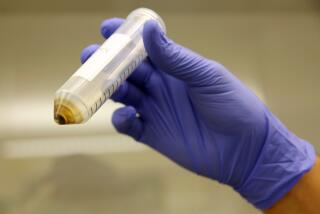Nanosponge soaks up toxins in blood
Researchers at UC San Diego have invented a microscopic sponge that can mop up toxins, including a drug-resistant staph bacterium and even snake venom.
The so-called nanosponge was tested only on mice. It worked well when injected into healthy mice that then were infected with the toxin from a strain of Staphylococcus aureus that has become resistant to multiple antibiotics. About 89% survived the lethal doses. Fewer than half, or 44%, survived when the nanosponge was injected after the infection.
Scientists have been focusing on the virus-sized sponges as a way to deliver highly specialized drugs for treatment of a particular cancer.
The UC San Diego research, however, adapts the sponges to a wider array of pathogens, which could lead to a super-drug that would combat many illnesses. They aim at pore-forming toxins that destroy cells by poking holes in them.
“Instead of creating specific treatments for individual toxins, we are developing a platform that can neutralize toxins caused by a wide range of pathogens, including MRSA and other antibiotic-resistant bacteria,” said Liangfang Zhang, a nano-engineering professor at the UC San Diego Jacobs School of Engineering and the senior author on the study.
The sponges use a clever disguise previously developed by the same researchers: They are coated in red blood cell membranes, so they appear like regular red blood cells and act as decoys, attracting the toxins.
The sponges eventually are processed by the liver, which apparently doesn’t suffer any damage, according to the researchers.
Researchers at Vanderbilt University two years ago showed that nanosponges were three to five times more effective at reducing tumor growth than direct injection. In that study, researchers essentially covered the nanosponges with chemicals that bond to part of a tumor cell. Once they find each other, the nanosponge releases the drug into the errant cell.







